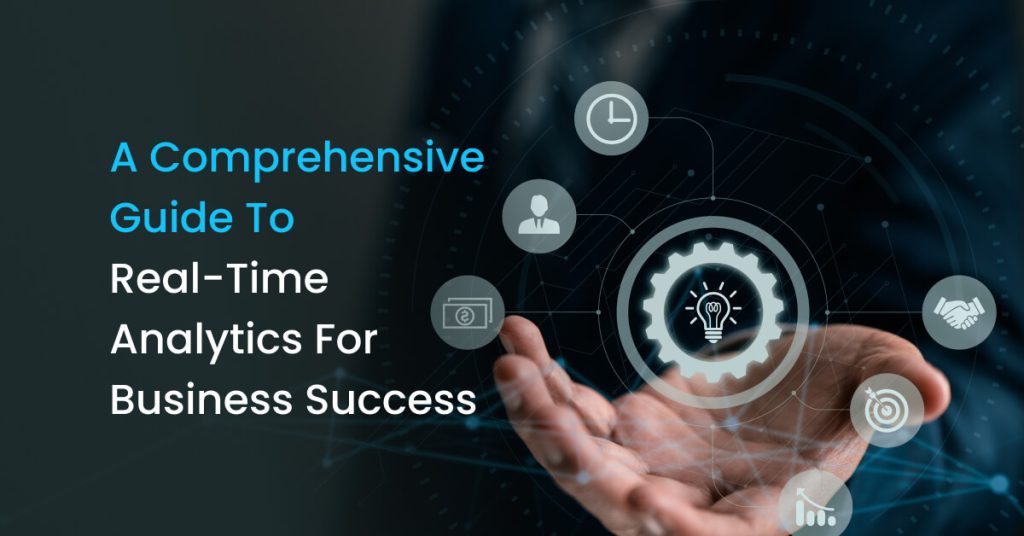
In the fast-paced world of business, the significance of real time analytics cannot be overstated. The convergence of real-time analytics and big data has opened new avenues for enterprises, promising valuable insights and data-driven decision-making. In this comprehensive guide, we will explore the realm of real-time analytics and how it can propel your business towards success.
Real-time analytics, a term that may seem straightforward at first glance, can be surprisingly multifaceted. The very definition of “real-time” varies from one organization to another and, more specifically, from one business task to another. As we delve into this comprehensive guide, we’ll explore the nuances of real-time analytics and how it drives success in the business world.
Defining Real-Time Analytics
Before we proceed, it’s essential to establish a clear understanding of real-time analytics. Our big data consulting experts have framed the definition as follows:
“Real-time big data analytics involves processing large volumes of data as it arrives. The goal is to provide actionable insights within a predefined timeframe for decision-making, or to trigger specific actions and notifications within the business system.”
It’s crucial to distinguish real-time analytics from the concept of “instantaneous” data processing. The key differentiator lies in the timeframes for data input and response.
In the realm of real-time analytics, data input methods can be categorized into two primary approaches. The first is the “push” method, which involves the continuous flow of high-volume data, often referred to as streaming data. However, it’s worth noting that not all real-time processing engines are equipped to handle streaming data. Alternatively, the “pull” method allows the system to periodically request new data. The frequency of these requests varies based on specific business needs and can span from mere milliseconds to several hours.
Real-time analytics entails varying response times, depending on the nature of the business task. Consider these scenarios:
- High-Speed Requirements: Applications like self-driving cars demand incredibly fast response times, often measured in milliseconds. Safety-critical decisions hinge on the real-time processing of data.
- Moderate Response Times: In cases where sensors on equipment, such as wind turbines, detect slowly rising gearbox oil temperatures, a response time of one minute might be sufficient. This allows for proactive adjustments, preventing potential machine breakdowns or safety hazards.
- Flexible Timelines: Industries like banking and retail introduce flexibility into the real-time equation. Banks might permit several minutes to assess the creditworthiness of an applicant, while retailers’ dynamic pricing models might take up to an hour to update. In all these instances, the term “real-time” applies, but the specific timing requirements vary significantly.
Competitive Advantage – Real-time analytics
In today’s competitive business landscape, the ability to harness real time analytics is the key to gaining a competitive edge. While many organizations recognize the value of managing data in real time, not all of them take the leap into real-time big data analytics. This hesitation may stem from factors such as a lack of expertise, budget constraints, fear of associated challenges, or reluctance from the management team. However, it’s essential to understand that those companies that do implement real-time analytics open the door to unprecedented advantages.
Imagine you are a fashion retailer aspiring to provide exceptional customer service. Real-time big data analytics can transform this aspiration into reality. For instance, as a customer walks past your store, they receive a personalized push notification on their smartphones, enticing them to step inside. This notification is crafted based on their past purchases and online browsing history. Once the customer enters the store, your staff is instantly notified through their mobile apps. They are equipped with valuable insights into the customer’s recent purchases, style preferences, interest in promotions, typical spending habits, and more. This scenario creates a win-win situation for both customers and retailers, enhancing the shopping experience and boosting sales.
The power of real time analytics isn’t limited to the fashion industry. E-commerce retailers, for example, can significantly improve their performance by leveraging real-time data analysis. A common challenge in e-commerce is abandoned shopping carts, where customers begin the purchasing process but fail to complete it. Real time analytics steps in to address this issue effectively. By delving into the customer’s profile data, purchase history, and online behavior, the system can compare their actions with those of similar customers and their responses to various incentives. The analysis results guide the system in selecting the most appropriate action, such as offering a personalized discount to persuade the customer to complete the purchase.
Real time analytics is a real-time data processing powerhouse that has transcended its niche role to become a pivotal tool for businesses of all sizes. In an age where the pace of data generation is relentless, organizations can no longer afford to rely solely on historical insights. Real time analytics offers the ability to act instantaneously on data as it flows in, opening a spectrum of opportunities.
Real-Time Insights for Personalized Customer Experiences
Let’s further explore the retail scenario to grasp the profound impact of real time analytics. The initial step, recognizing customers as they enter the store, is not just about identification; it’s about understanding their preferences and behaviors in real-time. Beyond gender-based demographics, real time analytics can assess whether a customer is a first-time visitor or a loyal patron. It can also consider contextual factors, such as the time of day and the store’s operational hours. These insights are the building blocks of personalized experiences.
Real time analytics not only provides information but also fuels actionable responses. The data is channeled to dashboards for immediate access or triggers notifications and system actions. For instance, the retailer can dynamically allocate staff and resources based on the number of customers present, optimizing operational efficiency.
Navigating the Shopping Aisle with Real Time Analytics
In today’s tech-savvy retail landscape, it’s not uncommon for customers to use mobile apps to create shopping lists. Real time analytics takes this a step further. By harnessing location data from beacons and swiftly processing it, the app can provide customers with optimal routes through the store, ensuring they efficiently retrieve the items on their lists. This seamless integration of real-time data and customer convenience underscores the transformative potential of real time analytics.
Machine learning plays a starring role in this narrative. Although it doesn’t happen in real time, machine learning is the wizard behind the curtain, tirelessly analyzing vast volumes of historical data over extended periods—often spanning a year or more. It crafts models that enable real-time recommendations. These models are cultivated based on customer profiles, behavioral patterns, purchase history, and responses to marketing campaigns. The result is an array of personalized recommendations, ensuring that customers are continually engaged during their shopping journey.
- Model Verification: Ensuring Accuracy
To maintain the precision of real-time recommendations and decisions, model verification applications enter the stage. They act as gatekeepers, constantly refining and validating the accuracy of the models. Moreover, they filter out erroneous or noisy data, ensuring the quality of the input information. This continuous improvement process is vital for the sustained effectiveness of real time analytics in delivering real value to businesses and their customers.
- The Crucial Role of Data Storage
Real time analytics requires a robust data storage strategy. This strategy consists of two vital components: the data lake and the data warehouse. The data lake serves as the repository for raw or minimally processed data, preserving the richness of information. In contrast, the data warehouse acts as the data refinery, extracting, transforming, and condensing the data from the data lake. This duality ensures that data remains accessible, organized, and optimized for analysis.
- Real Time Analytics in Context
In the grand scheme of a retailer’s data strategy, real time analytics is not an isolated entity but a dynamic piece of a larger puzzle. Data analytics modules, driven by intricate algorithms and statistical models, perform complex analyses. These analyses may take time, potentially hours or more, but the insights they yield are well worth the wait. As such, a retailer’s analytical dashboards are an amalgamation of real-time and historical data, providing a comprehensive view of the business’s performance.
Conclusion
Real time analytics, when meticulously planned and executed, can unquestionably confer a decisive competitive edge to businesses. However, it’s crucial to acknowledge the diverse interpretations of ‘real-time’ and to gain a comprehensive understanding of how this aligns with your company’s specific analytical requirements.
In this comprehensive guide, we will delve into the essential aspects of real time analytics, shedding light on its potential and implications for business success. To embark on this journey, it’s vital to appreciate the nuances of real time analytics and discern how they can be tailored to meet both short-term and long-term business needs.
One of the pivotal elements in harnessing the power of real time analytics is to comprehend the architectural framework of a real-time data analytics solution. While the article touched upon a typical architecture, it’s crucial to assess whether it adequately addresses your immediate and long-term business objectives.
The question to ask is, does the proposed solution align with your unique operational demands? If, for any reason, you find that it falls short or needs fine-tuning, seeking expert guidance is a prudent course of action. There are professionals well-versed in tailoring real time analytics solutions to meet your distinct needs, and their insights can be invaluable in ensuring your business’s success.
SquareOne – Delivering Real Time Analytics Solution for Business Success
At SquareOne, we understand that real time analytics isn’t a one-size-fits-all approach. We also understand that its effectiveness hinges on its seamless integration with business’s real-time aspirations. Whether you’re looking to streamline your operations, enhance customer experiences, or gain a competitive edge, SquareOne’s expertise in real-time analytics is the key to your success.
Real-time analytics has the potential to be a game-changer for businesses in today’s data-driven world. However, realizing its true potential requires more than just technology; it demands a deep understanding of your specific needs, a well-tailored architecture, and the willingness to seek professional advice when necessary.
SquareOne is not just a solutions provider; we are your strategic partner in unlocking the full power of real-time analytics for unparalleled business success. Our expertise, coupled with our commitment to tailoring solutions to your unique requirements, sets us apart in this field. With SquareOne, you’re not just embracing real-time analytics; you’re embracing the future of your business.
Make the smart choice today and let SquareOne guide your journey towards real-time analytics excellence.
Your success story begins here.















